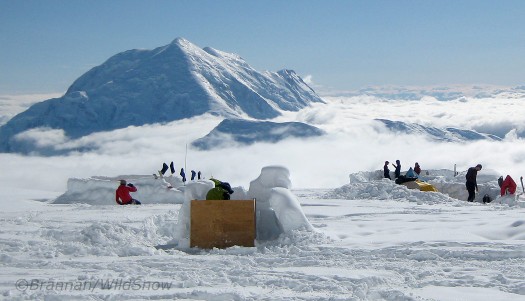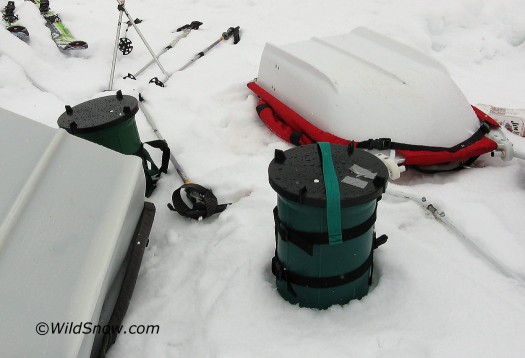When I began blogging our Denali adventure, I promised some of you I’d leave no “stone” unturned when it came to subject matter. That was of course a bit strict of a promise as there are things done ‘neath the midnight sun that shall remain private matters. Nonetheless, we shall turn over a few new snow chunks and see what lies beneath.
In olden days of Denali mountaineering, climbers simply defecated on the glacier. Those with smarts at least tried to locate their poop in common latrines, buried to some degree. But over the years all too many climbers simply let lose wherever the urge hit them, sometimes not even burying their leavings.
Until recently, as Jon Waterman shares in his wonderful memoir “Shadow of Denali,” this resulted in a ludicrous if not criminal situation; that of climbing though a bathroom, as well as prevalent intestinal illness from consuming contaminated snowmelt water.
Enter the Park Service. Realizing that climbing over and through fecal matter was not exactly the experience they wanted to offer people, and realizing that if folks were melting snow for water they were at risk of disease from all pervasive fecal particles blown in the winds, the Park Service has implemented a host of solutions.
Mainly, the Rangers made open defecation on the glacier against the rules, and instead supply all climbers with a Clean Mountain Can (CMC) in which you leave your solid offerings in a biodegradable plastic bag, which when filled you toss in a deep crevasse. The idea is to keep your crap off the glacier surface, and allow the gigantic river of ice to dilute and process your human sewage so that once it travels the 30 or 40 miles to the glacier toe, then gets melted out and washed by the glacial waters, nothing is left but elemental particles.
The same process is used for urination, only it’s done a little more casually by designating a series of “pee holes” that everyone is supposed to use at the camps. The pee holes end up melting deep into the glacier and form an effective disposal system (not to mention hazards you could actually fall into like a crevasse). On the trail you pee where needed, and from what I saw the amount of that compared to the scale of the glacier results in minimal problems. Or perhaps everyone is so dehydrated they just wait till camp to empty their bladders.
To enhance the CMC system, the Park Service digs two deep latrines at the 14,200 foot camp, over which they place plywood box covers, one with a slit opening and one with a toilet seat. The pits are simply closed up after a degree of use and allowed to sink into the glacier and travel down the valley.
The rangers said they’ve been detailed to find what happens to the pits as they get taken down the valley, but they’ve not been able to find any. Their theory is they get somewhat encapsulated until near the end of the glacial flow, where they finally melt out and receive their dilution and distribution by mother nature. I asked about how the Kahlitna Glacier’s water tested, and the word is there is no problem at this time. When you realize the vast scale of this thing compared to the amount of human debris, this is really no surprise, though the concept is a bit hard to grasp for those of us from tiny states with millions of people going to the bathroom.
While the concept of using the glacier and CMC cans for disposal appears to be workable, at least with the current level of climber activity, the system isn’t perfect.
Biggest problem is with the CMC cans themselves. For starters, the things are so small (12 inch diameter cylinder about 16 inches long) you have to be a contortionist to use them. That alone is somewhat of a disincentive and you do see raw crap here and there on the glacier. But worse, the company the Park Service uses to process the CMC containers uses some kind of obnoxious and smelly disinfectant. I found that once we’d picked up the cans in Talkeetna, one touch with my gloves or hands and the nauseating smell was transferred to my clothing, thence to my sleeping bag, and even to my trail food. This was so annoying and sickening that I can honestly say it was the worst bummer of the trip for me, and actually ruined some of my meals and snacks. The solution to this would be so easy, just use something more odor free to process the cans. But hey, it’s a government subcontractor…
If you’re headed up there, my suggestion is to plan on cleaning your CMC can or cans before you leave Talkeetna. This could be done with a bucket of soapy water and a rinse. Clean them inside and out to get rid of the noxious odor and residue, otherwise, if you’re sensitive to that sort of thing, you may be in for a bummer as I was.
The other problem with the Park Service glacier bathroom system is with the latrines at 14,200 feet. These things are never cleaned in the normal sense of the word, and eventually resemble something you’d find in Lima, Peru or any other third world bathroom. To compensate, you master the art of not touching ANYTHING, and you worry about what you do with your camp booties once back near your tent (you definitely don’t get in your sleeping bag with them on!).
Considering all this, the use of hand sanitizer is of course an essential and frequent act while on the glacier. And not just on your hands; on your gloves as well, and perhaps even your camp boot soles.
Funniest part of the whole deal is that the slit latrine cover at 14,200 feet has such a big opening you could easily fall in. To reduce risk of such, a daisy chain is present you can clip your harness to, or grab onto with your hands. Kind of scary to touch anything in there, but then, taking the plunge could be deadly as the pit is deep.
So there you go — it’s not just astronauts who excrete with unusual methodology — mountaineers do as well, and with just as good a view!
WildSnow.com publisher emeritus and founder Lou (Louis Dawson) has a 50+ years career in climbing, backcountry skiing and ski mountaineering. He was the first person in history to ski down all 54 Colorado 14,000-foot peaks, has authored numerous books about about backcountry skiing, and has skied from the summit of Denali in Alaska, North America’s highest mountain.


